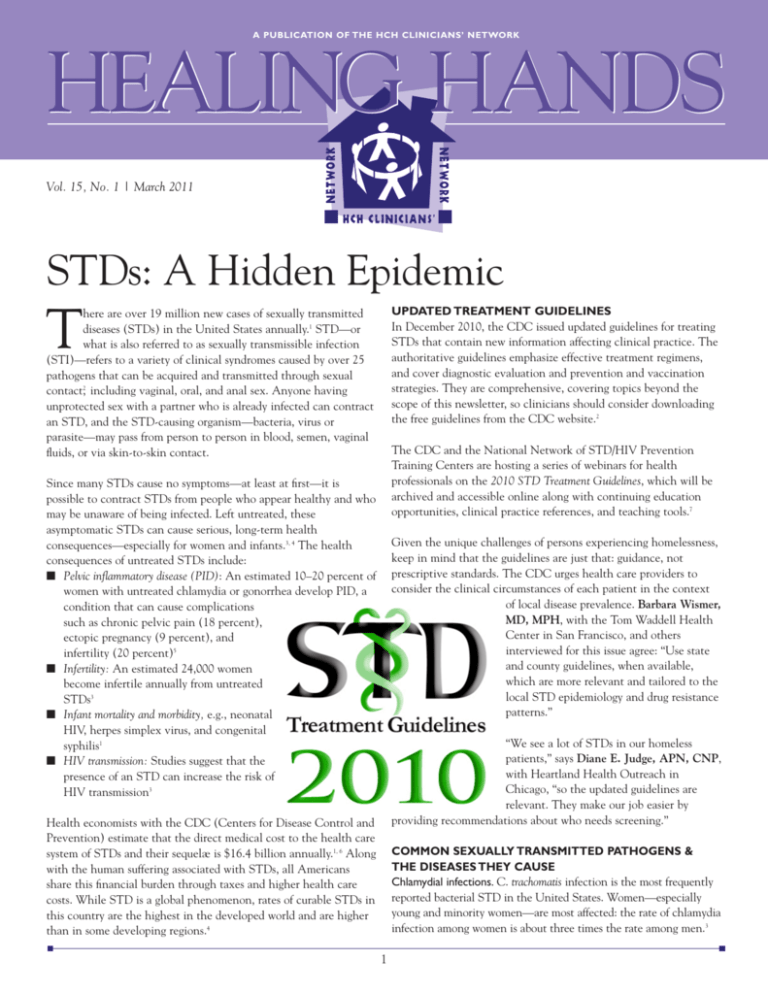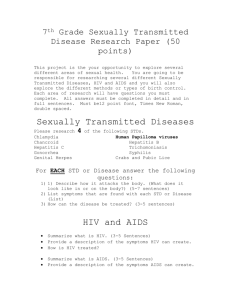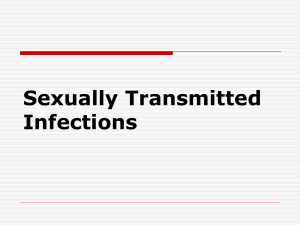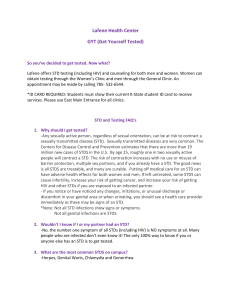
A PUBLICATION OF THE HCH CLINICIANS’ NETWORK
HEALING HANDS
Vol. 15, No. 1 | March 2011
STDs: A Hidden Epidemic
UPDATED TREATMENT GUIDELINES
In December 2010, the CDC issued updated guidelines for treating
STDs that contain new information affecting clinical practice. The
authoritative guidelines emphasize effective treatment regimens,
and cover diagnostic evaluation and prevention and vaccination
strategies. They are comprehensive, covering topics beyond the
scope of this newsletter, so clinicians should consider downloading
the free guidelines from the CDC website.2
T
here are over 19 million new cases of sexually transmitted
diseases (STDs) in the United States annually.1 STD—or
what is also referred to as sexually transmissible infection
(STI)—refers to a variety of clinical syndromes caused by over 25
pathogens that can be acquired and transmitted through sexual
contact,2 including vaginal, oral, and anal sex. Anyone having
unprotected sex with a partner who is already infected can contract
an STD, and the STD-causing organism—bacteria, virus or
parasite—may pass from person to person in blood, semen, vaginal
fluids, or via skin-to-skin contact.
The CDC and the National Network of STD/HIV Prevention
Training Centers are hosting a series of webinars for health
professionals on the 2010 STD Treatment Guidelines, which will be
archived and accessible online along with continuing education
opportunities, clinical practice references, and teaching tools.7
Since many STDs cause no symptoms—at least at first—it is
possible to contract STDs from people who appear healthy and who
may be unaware of being infected. Left untreated, these
asymptomatic STDs can cause serious, long-term health
consequences—especially for women and infants.3, 4 The health
consequences of untreated STDs include:
n Pelvic inflammatory disease (PID): An estimated 10–20 percent of
women with untreated chlamydia or gonorrhea develop PID, a
condition that can cause complications
such as chronic pelvic pain (18 percent),
ectopic pregnancy (9 percent), and
infertility (20 percent)5
n Infertility: An estimated 24,000 women
become infertile annually from untreated
STDs3
n Infant mortality and morbidity, e.g., neonatal
HIV, herpes simplex virus, and congenital
syphilis1
n HIV transmission: Studies suggest that the
presence of an STD can increase the risk of
HIV transmission3
Given the unique challenges of persons experiencing homelessness,
keep in mind that the guidelines are just that: guidance, not
prescriptive standards. The CDC urges health care providers to
consider the clinical circumstances of each patient in the context
of local disease prevalence. Barbara Wismer,
MD, MPH, with the Tom Waddell Health
Center in San Francisco, and others
interviewed for this issue agree: “Use state
and county guidelines, when available,
which are more relevant and tailored to the
local STD epidemiology and drug resistance
patterns.”
“We see a lot of STDs in our homeless
patients,” says Diane E. Judge, APN, CNP,
with Heartland Health Outreach in
Chicago, “so the updated guidelines are
relevant. They make our job easier by
providing recommendations about who needs screening.”
Health economists with the CDC (Centers for Disease Control and
Prevention) estimate that the direct medical cost to the health care
system of STDs and their sequelæ is $16.4 billion annually.1, 6 Along
with the human suffering associated with STDs, all Americans
share this financial burden through taxes and higher health care
costs. While STD is a global phenomenon, rates of curable STDs in
this country are the highest in the developed world and are higher
than in some developing regions.4
COMMON SEXUALLY TRANSMITTED PATHOGENS &
THE DISEASES THEY CAUSE
Chlamydial infections. C. trachomatis infection is the most frequently
reported bacterial STD in the United States. Women—especially
young and minority women—are most affected: the rate of chlamydia
infection among women is about three times the rate among men.3
1
HEALING HANDS
A PUBLIC ATION OF THE HCH CLINICIANS’ NETWORK
Major medical associations and the CDC recommend that all
sexually active women younger than age 26 receive an annual
chlamydia screening. In spite of being cost-effective, chlamydia
screening is an underutilized form of preventive health care because
of its potential for helping to reduce PID rates.8 Data suggest that
chlamydia screening can reduce the incidence of PID by as much as
60 percent. Still, many women at risk are not being tested due to
lack of awareness among some clinicians and the limited resources
available to support screenings.5
Table 1. Recommended regimens for uncomplicated
gonococcal infections
Ceftriaxone in a single injection of 250 mg.
or, if not an option:
Cefixime 400 mg. orally in a single dose
or, if not an option:
Single-dose injectable cephalosporin regimens
plus
Azithromycin 1 g. orally in a single dose
or
Doxycyline 100 mg. orally twice a day for seven days
Gonococcal infections. Gonorrhea, the second most commonly
reported bacterial STD, is caused by Neisseria gonorrhoeae, a
bacterium that can grow and multiply easily in the warm, moist
areas of the reproductive tract, including the cervix, uterus, and
fallopian tubes in women, and in the urethra in women and men.
The bacterium can also grow in the mouth, throat, eyes, and anus.9
Source: CDC, Sexually Transmitted Diseases Treatment Guidelines, 2010, p. 502
the verge of elimination, syphilis reemerged as a public health threat
in 2001 and rates have increased steadily since then. The majority
of cases (62 percent) in the United States continues to be among
men who have sex with men (MSM). This is of particular concern
since HIV also heavily affects MSM, and like several other STDs,
syphilis can facilitate HIV transmission. Left untreated, syphilis can
lead to serious long-term complications, including brain,
cardiovascular, and organ damage, and even death. Penicillin given
as an injection is the preferred treatment of all stages of syphilis; the
dose and length of treatment depends on the disease stage.5, 3
The CDC estimates more than 700,000 new gonorrheal infections
occur annually in this country. Since the prevalence of gonorrhea
varies widely, clinicians should consider local epidemiology when
making screening decisions. CDC does not recommend widespread
screening, but screening young women—those under age 25 who are
at increased risk for infection—is a primary component of gonorrhea
control. Clinicians should also screen these high-risk groups:2
n Those living in communities with a high disease prevalence
n Those engaging in commercial sex work and drug use
n Women with previous gonorrhea infection, other STDs, new or
multiple sex partners, and inconsistent condom use
HPV. Human papillomavirus (HPV) is the most common
sexually transmitted virus in this country, and the CDC
estimates that at least 50 percent of sexually active individuals
will have genital HPV at some point in their lives. About 20
million Americans are currently infected, and another 6.2
million become newly infected each year.8 Most people do not
know that they have the virus, which spreads easily by skin-toskin contact during sexual activity.
Treatment. Gonorrhea is curable, but often goes untreated because
it can be asymptomatic. The ability of N. gonorrhoeae to develop
resistance to antimicrobial therapies further complicates treatment.
The recommendation for the 250-mg. ceftriaxone dose [Table 1] and
While the body’s immune system naturally clears about 90 percent
the addition of azithromycin or doxycycline—whether or not
of infections within two years without causing symptoms or health
chlamydia screening has been
problems, certain HPV strains
done and is positive—represents
cause genital warts, which can be
“STDs are public health problems that lack easy solutions because they are
an important change from
removed, although lesions may
rooted in human behavior and fundamental societal problems. Indeed,
there are many obstacles to effective prevention efforts. The first hurdle
previous guidelines.
reappear. Other high-risk HPV
will be to confront the reluctance of American society to openly confront
types can cause cervical and other
issues surrounding sexuality and STDs.”
While doxycycline may be given
less common but serious cancers if
if azithromycin is not an option,
left untreated.8 HPV causes
— Committee on Prevention & Control of Sexually Transmitted
4
this is not optimal for those
Diseases, Institute of Medicine, 1997, p. 43
virtually all cervical cancers.10
experiencing homelessness.
Azithromycin may be given in clinic or at an outreach site under
Despite high rates of HPV infection, cervical cancer incidence and
direct observation, which ordinarily cannot be done with a seven-day
mortality are on the decline in the United States primarily due to
course of twice daily doxycycline. Wismer says, “Single dose,
the widespread availability and use of the Pap test—also known as
presumptive treatment may be best for our patients since they may
the Pap smear. In addition to detecting treatable early stage cervical
have difficulty adhering to long or complex treatment, or may not
cancer, Pap tests detect cervical dysplasia—precancerous changes of
return or be reachable. Another consideration is that homeless people cervical cells—allowing for the removal of affected tissue before
are at higher risk for photosensitivity skin reactions from doxycycline
invasive cancer sets in.8
because it may be difficult or impossible to avoid sun exposure.”
Homeless women have a high prevalence of risk factors for cervical
Syphilis. A highly infectious disease caused by the bacterium
cancer, including HPV infection, multiple sex partners, HIV
Treponema pallidum, syphilis is curable in its early stages. Once on
infection, smoking, sporadic medical care, and less access to
2
HEALING HANDS
A PUBLIC ATION OF THE HCH CLINICIANS’ NETWORK
preventive care. A disproportionate number of deaths from cervical
cancer occurs in impoverished women; low socioeconomic status is
associated with higher rates of cervical cancer, lower rates of Pap
test screening, and poor follow-up of abnormal Pap smears.11
Table 2. Selected resources & websites
n 2010 STD Treatment Guidelines | www.cdc.gov/std/
treatment/2010
n American Social Health Association | www.ashastd.org
n CDC Division of STD Prevention |
www.cdc.gov/std/dstdp/default.htm
n Expedited Partner Therapy Toolkit | http://region8ipp.com/
epttoolkit/eptindex.htm
n Guttmacher Institute | www.guttmacher.org
n HPV: Human Papillomavirus | www.nhchc.org/HPV.html
n National Center for HIV/AIDS,Viral Hepatitis, STD & TB
Prevention | www.cdc.gov/nchhstp
n National Network of STD/HIV Prevention Training Centers |
www.nnptc.org
n National Prevention Information Network | www.cdcpin.org
n STD Treatment Guidelines Webinars | www.cdc.gov/std/
treatment/2010
n Treatment & Recommendations for Homeless Patients with
Chlamydial or Gonococcal Infections | HCH Clinicians’
Network, 2008 | www.nhchc.org/Publications/STI123108.pdf
n Treatment & Recommendations for Homeless Patients with
HIV/AIDS | www.nhchc.org/HIVguide2008.pdf
A study reported in the Journal of Women’s Health found that many
homeless women were reluctant to get Pap smears, even when
barriers to access and cost are removed. Researchers speculated that
the high incidence of previous trauma presents a barrier to
homeless women receiving Pap smear screening.11
HIV/AIDS. Those infected with STDs are at least two to five times
more likely than uninfected individuals to acquire HIV (human
immunodeficiency virus), the virus that causes AIDS (acquired
immune deficiency syndrome).12 Therefore, the CDC recommends
that all individuals seeking STD evaluation and treatment should
be routinely screened for HIV infection. Without treatment,
virtually all HIV-infected persons will die of AIDS.2
The CDC estimates that more than 1.1 million people are living
with HIV in the United States, and that one in five (21 percent)
individuals is unaware of his or her infection.13 According to the
National Coalition for the Homeless (NCH), hiv/aids and
homelessness are intricately related:14
n People living with hiv/aids (plwha) are in danger of losing
their jobs due to discrimination or as a result of frequent healthrelated absences; consequently, up to 50 percent of plwha are at
risk of homelessness
n Many homeless people inject drugs intravenously, and may
share or reuse needles, a practice responsible for 13 percent of
hiv/aids diagnoses
n plwha lack the ability to fight off disease, and crowded shelters
can expose them to infections such as hepatitis A, pneumonia,
tuberculosis, and skin infections
n Adherence to a complex regimen of antiretroviral treatment is
difficult for those lacking access to stable housing, clean water,
bathrooms, refrigeration, and food
n Most homeless people lack health insurance and cannot pay for
medications and services to treat hiv/aids
STDs in youth. In general, youth are at greater risk for contracting
STDs compared to other age groups. Experts estimate that almost
half the new cases of STDs each year occur in sexually active young
people aged 15–24 years5, 1 and that one in four (26 percent) young
women ages 15 to 19 has at least one of the most common STDs.16
Adolescence is a time of risk taking, perceived invulnerability,
and experimentation with adult activities such as alcohol, drugs,
and sex. In normal development, this experimentation takes place
in the milieu of adult monitoring, limitations, rules, and
consequences that may curb experimentation. Among runaway
and homeless teens, however, these moderating factors are
missing, and poor sexual health may be the outcome.17 While no
one knows the exact number of homeless teens, researchers
estimate a national prevalence of 1.6 million youth experiencing
homelessness each year.18, 19
Homeless youth are likely to be at higher risk for STDs than youth
in general for several reasons:17
n Extensive histories of abuse and neglect, which may result in
risky behaviors including substance abuse and trading sex for
food, shelter, money, or drugs
n Spending more time on the street, which exposes youth to drug
users, sexual predators, and others who might exploit them and
endanger their health
n Sexual practices such as inconsistent condom use and having
multiple sexual partners
The National AIDS Housing Coalition (nahc) reports that 3–10
percent of homeless people are HIV-positive, ten times the rate of
infection in the general population, and that 40–60 percent of
plwha experience homelessness or housing instability in their
lifetime. Based on recent research findings on HIV and housing,
the nahc recommends making subsidized, affordable housing
available to all low-income plwha to break the link between
homelessness and HIV.15
POPULATIONS AT DISPROPORTIONATE RISK
The three populations at greatest risk for STDs are youth, racial
and ethnic minorities, and men who have sex with men.1 For
African Americans and MSM, the high prevalence of STDs
within their communities can be a risk factor in itself, since
individuals are more likely to encounter an infected partner.8
GLBTQ youth. Service providers estimate that gay, lesbian,
bisexual, transgender, and questioning (glbtq) youth are
disproportionately experiencing homelessness. Research shows
that 15 to 25 percent of homeless youth self-identify a glbtq,
which is about twice the rate (i.e., 10 percent) estimated in the
3
HEALING HANDS
A PUBLIC ATION OF THE HCH CLINICIANS’ NETWORK
general youth population.19 A significant minority of glbtq
youth—one study estimates 25 percent—report being expelled
from their homes due to their sexual orientation or gender
identity.20 The harassment, social stigma, and discrimination
associated with being glbtq contribute negatively to their wellbeing, as evidenced by high rates of attempted and completed
suicide, violence victimization, substance abuse, teen
pregnancy, and std/hiv-associated risky behaviors.21
In other words, genetic predisposition and risky behaviors only
partially explain why some people become sick and others do not.22
Acknowledging the disparity in STD rates by race or ethnicity can
be an initial step in empowering affected communities to organize
and focus on this public health problem.5 Although inconsistency
in reporting may distort the extent of these disparities, the
disparities are real.8
People of color are a minority that is overrepresented among the
homeless population:23, 24, 25
n 42 percent are African American (compared to 11 percent of
the general population)
n 13 percent are Hispanic (compared to 9 percent of the general
population)
n 4 percent are Native American (compared to 1 percent of the
general population)
Improving the sexual health of homeless youth. Research indicates that
youth who are part of groups educated about safe sexual practices
may be less likely to be coerced by others into using drugs, trading
sex, or engaging in unsafe sex. A holistic approach to intervention
may improve the sexual well-being of youth, and interventions that
may lower the risk for STDs include:17
n Targeting individuals and their partners
n Holding peer groups in nonjudgmental settings
n Using education in shelters to improve STD awareness
n Distributing free condoms and informative brochures
n Providing access to counselors
n Improving youth self-efficacy
n Teaching sexual negotiation skills
n Increasing access and referrals to street clinics
Promoting health equity & addressing racial disparities. A health
inequity is a difference in health outcomes that is systematic,
avoidable, and unjust; health equity means a fair distribution of
health determinants, outcomes, and resources among population
segments, regardless of social standing. Achieving equity requires
special and continuous efforts to improve the health of those who
have experienced social or economic disadvantage. It requires
focusing not only on eliminating health disparities, but also on the
living and working conditions that influence health status.
Moreover, it requires persistence to maintain the desired state,
after eliminating the disparities.22
STDs in racial & ethnic minorities. Out of all racial and ethnic
health disparities, STDs are among the highest.1 CDC surveillance
data show higher rates of reported STDs among some racial or
ethnic minority groups when compared with rates among whites. In
the United States, race and ethnicity are risk markers that correlate
with other fundamental determinants of health status such as:5, 8
n Poverty
n Lack of access to health care services
n Health care-seeking behavior
n Substance abuse
n Living in communities with a high prevalence of STD
Recognizing the critical need to reduce the severe racial disparities
in STD rates, especially for African Americans,3 in 2010 the CDC
convened an STDs Disparities Stakeholders Group to discuss the
issue and make suggestions for CDC consideration so that the
agency can strengthen and expand its prevention, diagnostic, and
treatment efforts.26
STDs in men who have sex with men. Subgroups of MSM are at
high risk for HIV infection and other STDs. These subgroups
include MSM from racial/ethnic minority groups and among those
using nonprescription drugs during sex, particularly
methamphetamine and volatile nitrites (“poppers”). Since the mid1990s, increased rates of unsafe sexual behaviors and increased rates
of P&S syphilis, gonorrhea, and chlamydial infection have been
documented among MSM. These trends may reflect changes in:2
n Attitudes about HIV infection that have accompanied advances
in HIV therapy
n Changing patterns of substance abuse
n Demographic shifts in MSM population
n Changes in sex partner networks associated with new venues for
partner acquisition, e.g., the Internet
Table 3. Summary of STD rates among defined
populations, 2009 data
n African Americans: Chlamydia rates were highest among black men
and women, more than eight times higher than that in whites; the
rate of gonorrhea among blacks was 20.5 times higher than the
rate among whites; and the overall rate of primary and secondary
(P&S) syphilis was nine times the rate among whites
n Hispanics/Latinos: STD rates in Hispanics include a chlamydia
rate nearly three (2.8) times higher than that of whites; a
gonorrhea rate 2.2 times higher among Hispanics than among
whites; and compared with whites, the rate of P&S syphilis was
2.1 times higher
n American Indians/Alaska Natives: STD rates included a chlamydia
rate 4.3 times that among whites; a gonorrhea rate 4.2 times
higher than among whites; and compared with whites, a rate of
P&S syphilis 1.1 times higher
Screening. These increasing infection rates highlight the need for
expanded prevention efforts. In 2009, MSM accounted for 62 percent
of all P&S syphilis cases in the United States, which is more cases
than men having sex with women or women in all racial and ethnic
Source: CDC, 2010, Sexually Transmitted Disease Surveillance 2009,
pp. 69–71 & p. 1095
4
HEALING HANDS
A PUBLIC ATION OF THE HCH CLINICIANS’ NETWORK
groups.5 The CDC recommends
that all sexually active MSM be
tested at least annually for syphilis
and for both chlamydia and
gonorrhea at all anatomic sites of
exposure (pharyngeal, urethral, and
anal/rectal).3
In addition to providing homeless
services, Tom Waddell Health
Center operates a transgender clinic.
“We screen our sexually active
transgender MSM clients for
STDs—HIV, chlamydia, syphilis,
gonorrhea—every six months,” says
Linette Martinez, MD, “and every
three months we screen higher-risk
patients who routinely engage in
unprotected sex.
“Examples of cases where people
don’t use condoms include couples
where both partners are HIV-positive;
sex workers going without condoms
in order to earn more; transgender
people who compete with biological
women for relationships and forgo
condoms to gain advantage; or those
in abusive relationships engaging in
unprotected sex to gain partner
approval.” According to the NCH,
the sexual orientation of homeless
persons is not often measured.23
Table 4. The Five Ps: Partners, Prevention of Pregnancy, Protection from STDs, Practices
& Past History of STDs
1. Partners
n “Do you have sex with men, women, or both?”
n “In the past two months, how many partners have you had sex with?”
n “In the past 12 months, how many partners have you had sex with?”
n “Is it possible that any of your sex partners in the past 12 months had sex with someone else while
they were still in a sexual relationship with you?”
2. Prevention of pregnancy
n “What are you doing to prevent pregnancy?”
3. Protection from STDs
n “What do you do to protect yourself from STDs and HIV?”
4. Practices
n “To understand your risks for STDs, I need to understand the kind of sex you have had recently.”
n “Have you had vaginal sex, meaning ‘penis in vagina sex’?” If yes, “Do you use condoms: never,
sometimes, or always?”
n “Have you had anal sex, meaning ‘penis in rectum/anus sex’?” If yes, “Do you use condoms: never,
sometimes, or always?”
n “Have you had oral sex, meaning ‘mouth on penis/vagina’?”
For condom answers:
n If “never”: “Why don’t you use condoms?”
n If “sometimes”:“In what situations (or with whom) do you not use condoms?”
5. Past history of STDs
n “Have you ever had an STD?”
n “Have any of your partners had an STD?”
Additional questions to identify HIV and viral hepatitis risk include:
n “Have you or any of your partners ever injected drugs?”
n “Have any of your partners exchanged money or drugs for sex?”
n “Is there anything else about your sexual practices that I need to know about to ensure you good
health care?”
Source: Adapted from CDC, Sexually Transmitted Diseases Treatment Guidelines, 2010, p. 32 and California
Chlamydia Action Coalition, 2001, pp. 1–330
KNOWING IS HALF THE BATTLE . . .
Since the 1990s, Case Manager Health Specialist Breonna M.
McCree has run peer support groups for Walden House in San
Francisco, which serves people affected by substance abuse and
mental illness. “Peer support is invaluable; you know where your
clients are because you’ve been there,” McCree says. “I know what
helped me, and hopefully, what will help them. Everything that I
say to my clients, I say to myself to keep myself on track.
SEX WORKERS & SURVIVAL SEX
Poverty, addiction, lack of education, and abuse are common causes
leading both men and women into the sex trade and homelessness.
Most women and youth who enter prostitution are survivors of
sexual abuse, and many use drugs or alcohol in order to cope with
past or current sexual violence in their lives.27 Survival sex—
exchanging sex for drugs, food, clothing, shelter or money—is high
among GLB homeless youth, and a strong predictor of HIV risk in
this population.28 Studies of homeless youth suggest somewhere
between 15–30 percent have engaged in commercial sex* or
exchanged sex for basic needs.29
“In this economy, where money is tight, those with the least are hit
hardest,” she says. “To cope with feeling overwhelmed, they often
turn to prostitution or to using or selling drugs. These risky
behaviors expose them to STDs, abuse, and sometimes death—
playing Russian roulette with their lives to have enough money to
pay for a hotel room.
Deborah Borne, MD, MSW, with Tom Waddell Health Center,
advises: “Don’t assume that your client isn’t doing commercial sex
work to survive; prostitution is a huge reality. Don’t be judgmental;
remember that substance abuse is a terrible disease and that poverty
sucks. People will do what they need to do to get food, and it’s not
just our clients doing sex work.”
“It seems the system is designed to keep people on the street,” McCree
says. “It’s easier to get drugs than to get addiction treatment. People
get discouraged trying to get into treatment; they give up and return
to old, comfortable behavior patterns. I tell my clients that we know
danger well and are comfortable with it; we know gloom, doom, and
destruction. We run toward danger instead of things that will improve
our lives and make us successful.
* The commercial sex industry involves business and commerce that
support pornography, stripping, phone sex, exotic dancing, mail-order
brides, transactional sex, and prostitution29
5
HEALING HANDS
A PUBLIC ATION OF THE HCH CLINICIANS’ NETWORK
© Care for the Homeless, Inc.
“I try to motivate my clients toward something positive
and encourage them to try something different.
Sometimes that first step is the hardest, and then they’re
off and running! I’m reminded of the GI Joe cartoons
from the ’80s that ended with a PSA message, giving
kids advice about life and how to stay safe. The PSA
would end with the phrase, Now you know, and knowing
is half the battle.”
THE CLINICIAN’S ROLE
Clinicians working with homeless people play a
critical role in preventing and treating STDs since
they have a unique opportunity to provide education
and counseling. Primary prevention of STDs begins
with changing the sexual behaviors that place persons
at risk for infection.2 CDC guidelines recommend that
clinicians routinely take clients’ sexual history as part
of the clinical interview, using skills characterized by
respect, compassion, and a nonjudgmental attitude.
Wismer adds: “It’s important to ask about intimate
partner violence and exchanging sex for money and
drugs to assess risk and explore prevention strategies.” Care for the Homeless Health Educator Wendy Ledesma providing information at a community health fair.
The CDC evaluated available evidence concerning expedited
partner therapy (EPT) for gonorrhea and chlamydial infections and
concluded that it is a useful option to facilitate partner
management, particularly in treating male partners of women with
chlamydial infection or gonorrhea.2, 31
Key interviewing techniques include using open-ended questions,
understandable language, and normalizing language. The Five Ps
approach to obtaining a sexual history [Table 4] can be an
effective template.
In addition to taking a sexual history, clinicians should encourage
STD risk-reduction and educate the client about specific actions
that can reduce the risk for STD transmission, for example:2
n Abstinence
n Condom use
n Limiting the number of sex partners
n Modifying sexual practices
n Pre-exposure vaccination
“When patients diagnosed with chlamydia or gonorrhea explain that
it’s doubtful that their partners will seek treatment, clinicians can
offer patient-delivered partner therapy, a form of EPT,” says Judge. “In
this case, the clinician provides the sex partners of infected persons
medications [or prescriptions] for the patient to take to his or her
partner without the provider first examining the partner. This hasn’t
always been standard practice, and the legal status of EPT varies by
state, so check the CDC website32 for information on the status of
EPT in your state.” Currently, eight states prohibit EPT.
Interactive counseling approaches and motivational interviewing
techniques are effective in STD/HIV prevention. For information
on these and other behavioral interventions, visit
http://effectiveinterventions.org.2
Along with the medication or prescription, clinicians should send
treatment instructions, appropriate warnings about taking
medications, and a statement advising that partners seek personal
medical evaluation—especially women who have symptoms of
STDs or PID.2 Clinicians in states where EPT is legal may refer to
the web-based Expedited Partner Therapy Toolkit provided by the
Region VIII Infertility Prevention Project33 and the CDC’s
Legal/Policy Toolkit for Adoption and Implementation of EPT.34
PUTTING EVIDENCE INTO PRACTICE: PARTNER
MANAGEMENT
Judge says, “The updated guidelines address partner management,
which is a range of activities designed to help prevent reinfection
and limit further STD transmission.” One activity on the
continuum is partner notification, where clinicians or public
health authorities learn about the partners of infected patients
and help to arrange for partner evaluation and treatment. The
CDC recommends encouraging patients with STDs to notify their
sex partners and urge them to seek medical evaluation and
treatment.2 “Another strategy,” Judge continues, “is to ask patients
to bring their partners with them when they return to the clinic
for further treatment.”
“Often our clients have multiple partners whom they cannot—or don’t
want to—locate, or they may be having survival sex, or it may be a
case of rape,” Judge says. “Even if they have one regular partner, women
particularly may fear telling partners that they have an STI because it
might result in physical or emotional abuse. Our public health
department only traces syphilis-positive results, so usually we are
unable to treat contacts of gonorrhea- or chlamydia-positive clients.”
6
HEALING HANDS
A PUBLIC ATION OF THE HCH CLINICIANS’ NETWORK
SEXUAL HEALTH: PRACTICE PEARLS
Engage & teach using creative games & incentives: Use fun, interactive
game formats and group sessions to teach clients about safer sex,
contraception, sexuality, STDs and hiv/aids. Examples of our
workshops are The Dr. Truth Show, which gives participants a chance
to ask a “sex expert” confidential questions related to sex; Who Wants
to be a Female Condom Expert? modeled on the TV game show Who
Wants to be a Millionaire?; the Sexual Drawing Game based on Pictionary,
where participants draw or use Play-Doh to teach each other about
safer sex; and the Sexual Health Game, based on the popular game show
Jeopardy! where participants learn about hiv/aids, STIs, safer sex, and
other sexual health facts.
well attended, have a reputation for being fun and educational, and
clients give good feedback and help spread the word to others.
— Lizanne Fontaine, Director of Health Services, & Lesley Moody,
Health Education Supervisor, Care for the Homeless, New York City
Practice trauma-informed care: Treat every client with dignity and
respect. Assume that all have experienced trauma, assume that all
have experienced sexual trauma, and assume that it’s hard for
everyone—including your staff—to talk about sex. Give everyone—
especially teens—autonomy to make decisions and to be in control
of their health care. Create a safe environment for clients and staff.
People are sexual beings; just because someone is homeless doesn’t
mean that they don’t have sex. When taking a sexual history, let the
client know that you ask these questions of everyone. Words can be
empowering; use client-centered words. Use the same words that
your client does. When asking, Have you had oral sex, meaning
‘mouth on penis/vagina’? say ‘I want to use the words that you use;
how do you say it?’
— Deborah Borne, MD, MSW, Tom Waddell Health Center
Announce the event about a week in advance, and invite clinicians
such as case managers and nurse practitioners to refer clients who
may benefit. Host the group in a location that will attract walk-ins
during the event. Have refreshments, and raffle prizes so everyone
who attends has a chance to win. Vet the curriculum to be sure that
the information is correct. Keep sessions to 60–90 minutes to
maintain the group’s attention. Following the game, include
discussion to reinforce your essential three or four take-away points.
Encourage follow-up: Make it clear that you care about the patient
and want them to return for follow-up. Patients need rescreening
three months following treatment to be sure that they haven’t been
reinfected. Stress that you need to be able to find them to give
them test results.
— Diane E. Judge, APN, CNP, Heartland Health Outreach
Advantages of this approach include engaging clients who otherwise
may be hard to reach; empowering clients and validating what they
know; providing opportunities to correct misinformation while diffusing
tension over “right” and “wrong” answers; and promoting use of your
services such as annual exams, vaccinations, or testing. Our groups are
REFERENCES
1. National Network of STD/HIV Prevention Training Centers (Producer).
(2011, January 13). 2010 STD Treatment Guidelines: An Overview by CDC
and the NNPTC. Webinar retrieved from http://www.nnptc.org
2. Centers for Disease Control and Prevention. (2010). Sexually Transmitted
Diseases Treatment Guidelines, 2010. Morbidity and Mortality Weekly Report,
59 (No. RR–12), 1–116. Retrieved from http://cdc.gov/mmwr
3. ———. (2009). CDC Fact Sheet. Sexually transmitted diseases in the United
States, 2008. National surveillance data for chlamydia, gonorrhea, and syphilis.
Atlanta, GA: U.S. Department of Health and Human Services. Retrieved
from http://www.cdc.gov/std/stats08/2008survFactSheet.PDF
4. Committee on Prevention and Control of Sexually Transmitted Diseases,
Institute of Medicine. (1997). Executive summary. In T. R. Eng & W. T.
Butler (Eds.), The hidden epidemic: Confronting sexually transmitted diseases
(p. 1). Washington, DC: National Academy Press. Retrieved from
http://www.nap.edu/catalog.php?record_id=5284
5. Centers for Disease Control and Prevention. (2010). Sexually transmitted
disease surveillance 2009. Atlanta, GA: U.S. Department of Health and
Human Services. Retrieved from http://www.cdc.gov/std/stats
6. ———. Email message to author, January 13, 2011.
7. ———. (2011). 2010 STD Treatment Guidelines. Online at
http://www.cdc.gov/STD/treatment/2010/
8. Guttmacher Institute. (2009). In brief: Facts on sexually transmitted infections
in the United States. New York, NY: Author.
9. Centers for Disease Control and Prevention. (2007). CDC Fact Sheet:
Gonorrhea. Atlanta, GA: U.S. Department of Health and Human Services.
Retrieved from http://www.cdc.gov/std/Gonorrhea/gonorrhea-fact-sheet.pdf
10. ———. (2011). CDC Features. Cervical cancer rates by race and ethnicity:
The Pap test and HPV vaccine can help prevent cervical cancer. Online at
http://www.cdc.gov/Features/dsCervicalCancer/
11. Bharel, M., Casey, C., & Wittenberg, E. (2009). Disparities in cancer
screening: Acceptance of Pap smears among homeless women. Journal of
Women’s Health, 18 (12), 2011–2016. Retrieved from
http://www.liebertonline.com/doi/pdf/10.1089/jwh.2008.1111
12. Centers for Disease Control and Prevention. (2007). CDC Fact Sheet. The
role of STD prevention and treatment in HIV prevention. Washington, DC:
U.S. Department of Health and Human Services. Retrieved from
http://www.cdc.gov/std/HIV/stds-and-hiv-fact-sheet.pdf
13. ———. (2010). CDC Fact Sheet. HIV in the United States. Atlanta, GA:
U.S. Department of Health and Human Services. Retrieved from
http://www.cdc.gov/hiv/resources/factsheets/PDF/us.pdf
14. National Coalition for the Homeless. (2009). Fact Sheet. HIV/AIDS and
homelessness. Washington, DC: Author. Retrieved from
http://www.nationalhomeless.org/factsheets/hiv.html
15. National AIDS Housing Coalition. (n.d.). Issue Fact Sheet. Breaking the link
between homelessness and HIV. Washington, DC: Author. Retrieved from
http://www.nationalaidshousing.org/toolkit/breaking_the_link.pdf
16. Centers for Disease Control and Prevention. (2008, March 13). Proceedings
from 2008 National STD Prevention Conference: Prevalence of sexually
transmitted infections and bacterial vaginosis among female adolescents in the
United States: Data from the National Health and Nutritional Examination Survey
(NHANES) 2003–2004. (Oral Abstract D4a). Retrieved from http://www.cdc.gov/
stdconference/2008/press/summaries-11march2008.htm#tues1
17. Tyler, K. A., Whitbeck, L. B., Chen, X., & Johnson, K. (2007). Sexual
health of homeless youth: Prevalence and correlates of sexually
transmissible infections. Sexual Health, 4(1), 57–61. Retrieved from
http://digitalcommons.unl.edu/cgi/viewcontent.cgi?article=
1042&context=sociologyfacpub
18. Paquette, K. (2010). HRC Resource. Unaccompanied youth experiencing
homelessness. Retrieved from http://www.nrchmi.samhsa.gov/
Resource/Unaccompanied-Youth-Experiencing-Homelessness-48807.aspx
19. Toro, P. A., Dworsky, A., & Fowler, P. J. (2007). Proceedings from 2007
National Symposium on Homelessness Research: Homeless youth in the United
States: Recent research findings and intervention approaches. Retrieved from
http://aspe.hhs.gov/hsp/homelessness/symposium07/toro/index.htm#Homeless
20. National Alliance to End Homelessness. (2008). Incidence and vulnerability of
LGBTQ homeless youth. Brief no. 2. Washington, DC: Author. Retrieved
from http://www.nyacyouth.org/docs/uploads/LGBTQ-Homeless-YouthIncidence-and-Vulnerability-2009.pdf
21. Advocates for Youth. (2010). The Facts: Gay, lesbian, bisexual, transgender
and questioning (GLBTQ) youth: A population in need of understanding and
support. Washington, DC: Author. Retrieved from
http://www.advocatesforyouth.org
7
Healing Hands
Healing Hands is published by the National Health
Care for the Homeless Council | www.nhchc.org
Brenda Proffitt, MHA, writer | Lily Catalano,
communications coordinator | MGroup, layout & design
HCH Clinicians' Network
Communications Committee
Bob Donovan, MD (Chair);Tina Carlson, APRN, BC;
Brian Colangelo, LCSW; Katy Kelleghan;
Michelle Nance, NP, RN;
Rachel Rodriguez-Marzec, MS, FNP-C, PMHNP-C;
Sara Stepahin, MA
Subscription Information
Individual Membership in the National Health Care
for the Homeless Council entitles you to a Healing
Hands subscription. Join online at www.nhchc.org;
Council Individual Membership is free of charge.
Address Change
Call: 615/226-2292
Email: ppetty@nhchc.org
Disclaimer
The Health Resources & Services Administration
supports the development and distribution of Healing
Hands. Its contents are solely the responsibility of the
authors and do not necessarily represent the official
views of HRSA/BPHC.
22. Centers for Disease Control and Prevention. (2010). National Center for HIV/AIDS, Viral
Hepatitis, STD, and TB Prevention annual report fiscal year 2009. Atlanta, GA: U.S.
Department of Health and Human Services. Retrieved from http://www.cdc.gov/nchhstp
23. National Coalition for the Homeless. (2009). Fact Sheet. Minorities and homelessness.
Washington, DC: Author. Retrieved from
http://www.nationalhomeless.org/factsheets/minorities.pdf
24. U. S. Conference of Mayors. (2006). A status report on hunger and homelessness in America’s cities:
2006, A 23-city survey. Author. Retrieved from http://usmayors.org/hungersurvey/2006/report06.pdf
25. Public Broadcasting Service. (2009). Facts and figures: The homeless. Online at
http://www.pbs.org/now/shows/526/homeless-facts.html
26. Planning, Facilitation, and Reporting Team, LTG Associates, Inc. (2010). Consultation
report. Framing conversation on sexually transmitted diseases disparities: What’s wrong? Why does
it matter? And, What should be done about it? Atlanta, GA: Centers for Disease Control
and Prevention.
27. Power, A. (2008). Income, employment & education: Sex trade. Retrieved from
http://www.homelesshub.ca/Topics/Sex-Trade-229.aspx
28. Gangamma, R., Slesnick, N., Toviessi, P., & Serovich, J. (2008). Comparison of HIV risks
among gay, lesbian, bisexual and heterosexual homeless youth. Journal of Youth and
Adolescence, 37(4), 456–464. Retrieved from
http://www.ncbi.nlm.nih.gov/pmc/articles/PMC2443720/pdf/nihms52853.pdf
29. National Alliance to End Homelessness. (2009). Solutions Brief: Homeless youth and sexual
exploitation: Research findings and practice implications. Washington, DC: Author. Retrieved
from http://news.change.org/stories/homeless-youth-and-survival-sex
30. California Chlamydia Action Coalition. (2001). A guide to sexual history taking. Berkeley, CA:
Author. Retrieved from http://www.stdhivtraining.net/educ/training_module/docs/08v2Guide-SexHist_Taking.pdf
31. Centers for Disease Control and Prevention. (2006). Expedited partner therapy in the
management of sexually transmitted diseases. Atlanta, GA: U.S. Department of Health and
Human Services. Retrieved from http://www.cdc.gov/std/treatment/EPTFinalReport2006.pdf
32. ———. (2010). Expedited partner therapy. Online at http://www.cdc.gov/std/ept/default.htm
33. Region 8 Infertility Prevention Project. (2009). Expedited partner therapy toolkit. Online at
http://region8ipp.com/epttoolkit/eptindex.htm
34. Arizona State University, Sandra Day O’Connor College of Law, in collaboration with the
Centers for Disease Control and Prevention. (2011). Legal/policy toolkit for adoption and
implementation of expedited partner therapy. Atlanta, GA: U.S. Department of Health and
Human Services. Retrieved from http://www.cdc.gov/std/ept/legal/EPT-toolkit-complete.pdf
Websites accessed February 2011








